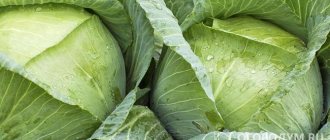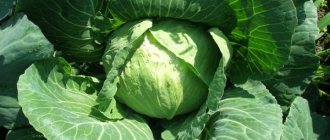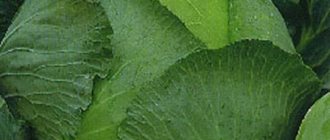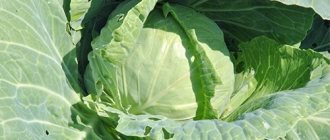General information and characteristics of Rinda cabbage
Rinda is a mid-season hybrid variety of white cabbage. Fruit harvesting begins 4-4.5 months after the appearance of the first shoots. Due to its beneficial properties, it is suitable for fresh consumption and processing. It can be prepared for the winter. Cabbage can be stored for 4 months. The shelf life can be extended by maintaining a certain temperature and humidity.
The variety has high taste qualities, characterized by juiciness and tenderness. Good transportability allows this cabbage to be sold far from the place of cultivation.
Appearance of Rinda cabbage
Rinda is suitable for cultivation in any climatic conditions. The variety is not prone to cracking even after overripeness.
For reference! The vegetable is enriched with amino acids, potassium, phosphorus, calcium, iron, manganese and vitamins A, B, C.
The variety is not susceptible to common diseases. It is also resistant to browning of the leaf edges. However, the variety can be damaged by slugs, cabbage and cruciferous flea beetles. The cabbage plant suffers from prolonged drought.
According to the description, Rinda cabbage has a dense spherical head of yellow-white color. Thin and elastic leaves of medium spreading are colored dark green. The light veins on the leaves are clearly visible. The leaves, located below and petiolate, are collected in a small rosette. The upper leaves are considered sessile. The lower part of the cabbage plant, that is, the stump, stands straight and branches. Its height reaches 0.15 m.
Typically, the weight of a vegetable varies between 3-6 kg. Experienced gardeners managed to obtain larger specimens, weighing almost 10 kg.
White cabbage blooms with yellow racemose flowers that are cross-pollinated by insects. Afterwards, black spherical seeds 2-3 mm in diameter are formed from the flowers, which are similar to swede, turnip and mustard.
Flowering cabbage Rinda
Important! The variety was bred in Holland by the Monsanto agricultural company. Dutch breeders were able to create a wonderful variety with excellent characteristics. In 1993, the variety was included in the state register of the Russian Federation.
History of selection
Rinda F1 is a hybrid variety bred on the basis of White Cabbage (Brassica oleracea var. capitata) by Dutch breeders of the Monsanto agricultural company. The crop has an average ripening period. Seeds of this variety can be found on sale under the Seminis label (this is the name of a subsidiary of Monsanto). Since 1993, the variety has been included in the State Register and recommended for the Central and Volga-Vyatka regions.
Cabbage Rinda F1 - a popular hybrid variety of Dutch origin
Advantages and disadvantages
The positive aspects of the variety include the following:
- decent yield;
- long shelf life;
- universal use;
- good taste;
- simultaneous ripening of heads of cabbage;
- attractive appearance;
- content of nutrients;
- resistance to temperature changes and cracking.
Among the disadvantages are increased demands on sunlight, susceptibility to drought, and intolerance to stagnant moisture.
Attention! The popularity of the variety has led to the risk of receiving fake seed material.
Rules for caring for cabbage
To get a good harvest, you need to properly care for the plant. Following the care recommendations will lead to a positive result.
Watering
You need to water the ground around the cabbage once every 3-4 days for the first two weeks. 1-1.5 liters of water are poured under each bush.
After 2 weeks, the entire soil is moistened. 8-10 liters of water are consumed per 1 m².
When heads begin to set, water consumption increases to 15-20 liters. In hot weather, cabbage is watered every other day.
Stop watering 14 days before ripening.
Loosening and hilling
The soil requires loosening after rains and watering to avoid the formation of a crust, which prevents the supply of oxygen to the roots.
- In summer, hilling is usually carried out 2-3 times.
- During the formation of a rosette of 5-6 leaves, the plant is spudded only once.
Feeding
The cabbage is fed for the first time 15-20 days after planting. A solution of urea (30 g per 10 liters of water) or ammonium nitrate (20 g per 10 liters of water) is suitable for this. For each bush, 0.5 liters of solution is used.
Boarding order
In Russian conditions, Rinda cabbage is grown using seedlings. First, seeds are planted at home. When the plants grow, they are transferred to an open area.
Preparing soil and seeds
To form seedlings you will need high-quality seeds. It is better to purchase them in specialized centers.
A light substrate with good ability to pass water and air is prepared for seedlings. The soil mixture is obtained by combining the following components:
- turf land (1 part);
- humus, vermicompost or peat (2 parts);
- perlite, sawdust, river sand to make the soil loose (1 part).
The resulting soil must be processed. To do this, place it in the freezer or heated microwave. Another treatment method is watering with a solution of Fitosporin, which has disinfecting properties.
Then they move on to preparing planting material. If the seeds are brightly colored, then they have already been processed by the manufacturer and are completely ready for planting.
Advice! The germination of seeds can be increased by treating them in a solution of humates or EM preparations.
Uncolored seeds should be heated in hot water at a temperature of 50 degrees. After half an hour, the material is immersed in cold water for 5 minutes. The treated seeds need to be dried, after which they can be used for planting.
Obtaining seedlings
The prepared soil is used to fill containers, the size of which depends on the method of growing cabbage.
If you plan to pick, it is better to use boxes. Soil is poured into them, after which holes are made 1 cm deep. The seeds are placed at a distance of 2 cm. Rows are formed 3 cm apart.
Advice! Rinda F1 cabbage is planted from the end of March until the end of April.
Without picking, the Rinda variety is planted in cups 10 cm deep. 2 seeds are planted in each container. After they germinate, they leave behind a stronger plant.
Containers must have holes. After planting the seeds, you need to sprinkle them with soil and water the plantings well. The containers are transferred to a warm place until shoots emerge.
Important! Rinda cabbage seeds germinate within a week.
Containers with seedlings are moved to the windowsill and kept at a temperature of no more than 8 degrees. Water the seedlings as the soil dries.
After a week, the ambient temperature is increased to 16 degrees by turning on the radiator. Excess heat is harmful to cabbage seedlings, so it is necessary to monitor temperature changes.
If the Rinda variety is planted in boxes, then two weeks after germination they are moved to separate containers.
Planting on the beds
The cabbage variety Rinda is planted in open ground after the seedlings have 4-6 leaves. Its height is 15-20 cm. Work is carried out from late May to mid-June.
A couple of weeks before work begins, the cabbage is left in the open air. At first, 2-3 hours are enough for hardening, gradually this period is increased. Before planting, cabbage should be left in the open all day.
Beds are prepared for cabbage, which are illuminated by the sun throughout the day. Mid-season varieties prefer loamy or clay soil. Do not use beds for planting the Rinda variety where radishes, radishes, mustard, turnips, rutabaga or any varieties of cabbage previously grew.
Important! In beds where cabbage was already growing, the crop is replanted after at least 3 years.
The soil for cabbage is dug up in the fall. In the spring, after the snow melts, its surface is leveled with a rake. Cabbage does not tolerate acidic soils. Adding dolomite flour will help reduce acidity.
The Rinda variety is placed in holes located every 30 cm. If planted more densely, the plants will not have enough space for full development.
One handful of peat and sand, two handfuls of humus and wood ash are placed in each hole. The seedlings are transferred into the holes along with a lump of earth. After planting, cabbage is watered abundantly.
Disease control methods
Cabbage variety Rinda is susceptible to some diseases. The most dangerous diseases and ways to combat them:
- Vascular bacteriosis. Signs: yellowing of foliage, black veins, rotting of the head. Treating the plant with Planriz will help with this. After 20 days it is carried out again.
- Cabbage mosaic. Symptoms are holes on the leaves and heads of cabbage, brown and black spots. In this case, the plant cannot be cured - it must be dug up with roots and burned.
- Blackleg. Manifestation: black rot that affects the stem of cabbage. The drug Granozan will correct the situation.
Cabbage affected by vascular bacteriosis
Important! Kila is considered another fatal disease.
Reviews
Last year we planted two varieties of cabbage - Rinda and Sugarloaf. We won’t plant Rinda anymore, as she was all cracked and the slugs were eating her.
Oussov
https://forum.prihoz.ru/viewtopic.php?t=2699&start=15
From cabbages I like to plant the Rinda variety, it doesn’t crack so much and ripens early.
Svetlana60
https://derevnyaonline.ru/user/anna1304/blog/8413.html
This is my third year planting Rinda cabbage. Heads of cabbage 3 kg, I liked growing them, the stalks don’t jump out of the ground! I kept it in the cellar until February! There are 10 pcs in a bag.
mlp1959
https://fialka.tomsk.ru/forum/viewtopic.php?t=16028
My mother always plants Rinda with seedlings herself. He says that it is the best cabbage for Siberia. And it goes into pickling (I confirm that it’s crispy and tasty) and ripens well.
Archives
https://fialka.tomsk.ru/forum/viewtopic.php?t=16028
And I’ve been growing only Rinda and Krautman for about 12 years now. Always guaranteed results. There are 10 seeds in the package, which means there will be 10 heads of cabbage weighing 2–3 kg. In those years when I was diligent with watering and fertilizing, they were 6–7 kg. And now I don’t have enough energy for everything, I water only when planting seedlings and even if it’s hot for a long time, a couple of times.
Svetlana Dobretsova
https://vk.com/topic-38740562_27116159
I like Rinda, better than the Dutch selection, every year I plant early ripening ones, Zapolyarye cabbage is very good, resistant to cracking. High yields.
Nadezhda Obukhova
https://vk.com/topic-38740562_27116159
Excellent Rinda cabbage! Today we pulled out the last head of cabbage, as if it had just come from the garden. The heads of cabbage are very dense, low, and white. Hurry up, it needs to be sown for seedlings before April 20th.
Olga Ivanova
https://ufsinhmao.ru/blogs/dohod/luchshie-sorta-ovoshnih-kultur-vashi-soveti-3.html
Rinda is an early ripening variety. It has a pleasant sweetish taste and always pleases with a large harvest with timely watering and loosening. The best way to preserve Rinda cabbage is to pickle it.
Collection and storage rules
Harvesting takes place from August to September.
Cabbage is harvested in warm weather without rain. This will significantly increase the shelf life of heads of cabbage that are cut from the stem. The head of cabbage will last only a month in the refrigerator.
Under the right conditions, Rinda can be stored for 2-4 months in boxes, containers or bags in a dry, dark place. Humidity should be 85% and temperature - from -1 °C to +2 °C. The room will need to be ventilated every 1-2 months.
Rinda is an excellent variety for those new to growing cabbage. It has gained recognition all over the world, and is now becoming popular among domestic summer residents.











